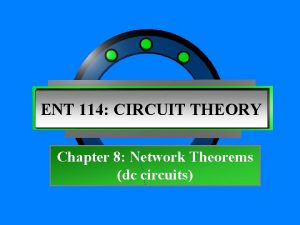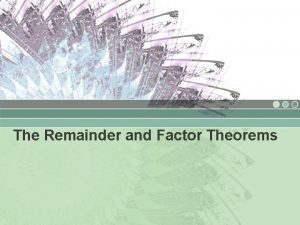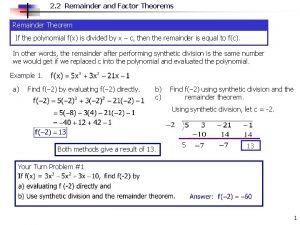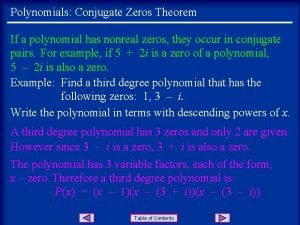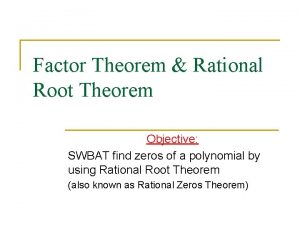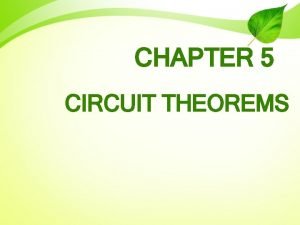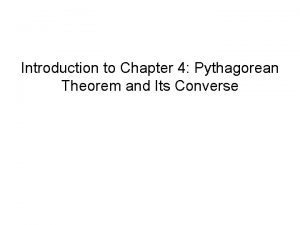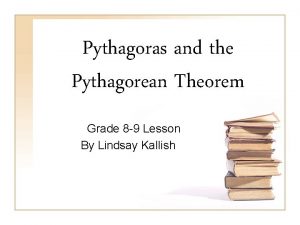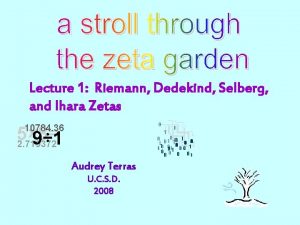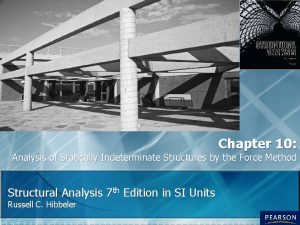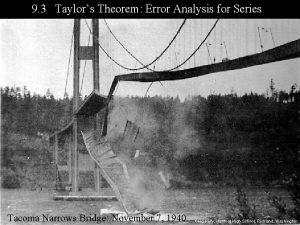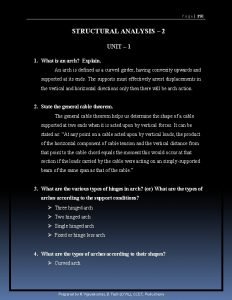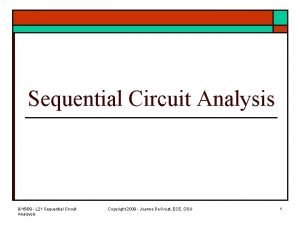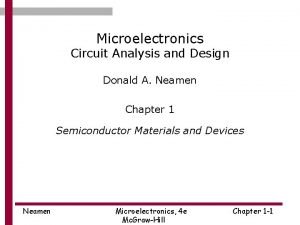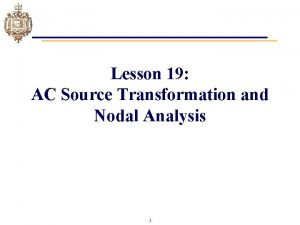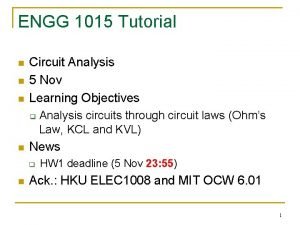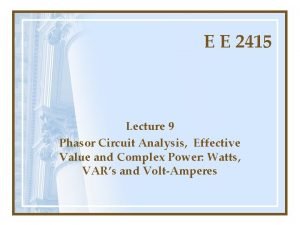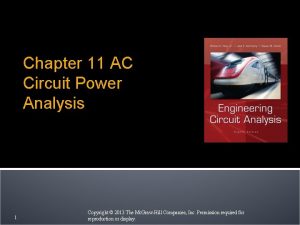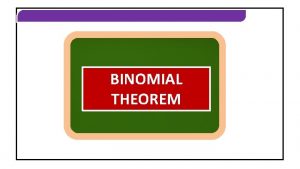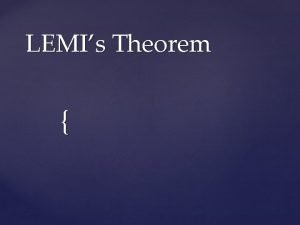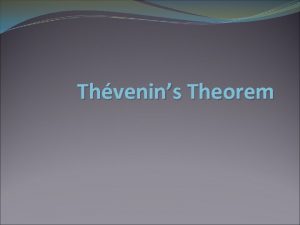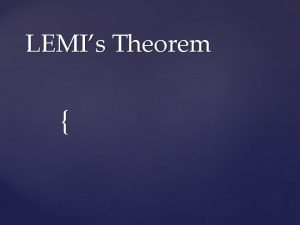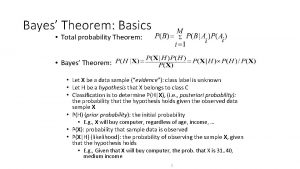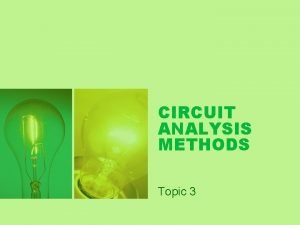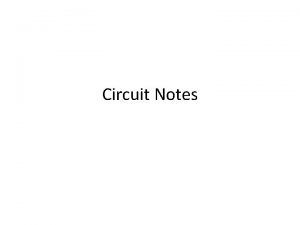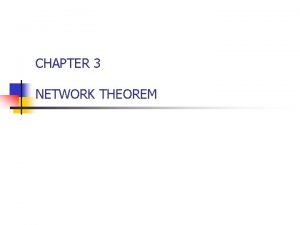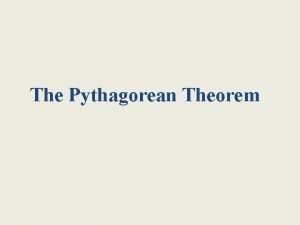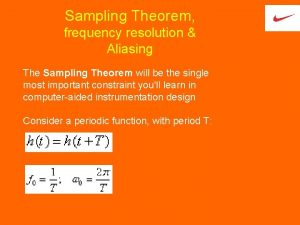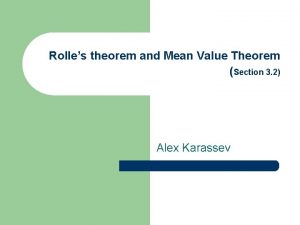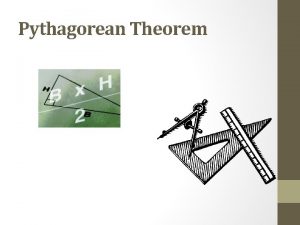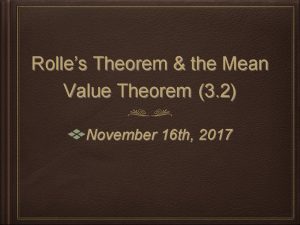Chapter 2 DC Circuit Theorem Circuit Analysis Introduction
































- Slides: 32

Chapter 2 DC Circuit Theorem & Circuit Analysis

Introduction n Circuit theorems: q q n Thevenin’s Theorem Norton’s Theorem Techniques for circuit analysis: q q Nodal analysis Mesh analysis Source transformation technique Superposition technique

Circuit Theorem Thevenin’s & Norton’s Theorems • To simplify complicated circuit consists of resistors and voltage source or current source into simple circuit. • Thevenin’s Theorem : Simplify complicated circuit into simple circuit consists single voltage source and single resistor connected in series. • Norton’s Theorem : Simplify complicated circuit into simple circuit consists single current source and single resistor connected in parallel.

Thevenin’s Theorem Thevenin’s theorem states that a linear two–terminal circuit can be replaced by an equivalent circuit consisting of a voltage source VTh in series with a resistor RTh. VTh is the open circuit voltage at the terminals. RTh is the input or equivalent resistance at the terminals when the independent sources are turned off. Outside network Complicated circuit consisting of resistors and voltage source Thevenin’s equivalence circuit

Thevenin’s Theorem Step 1 : Disconnect the Outside Network (Load). Calculate voltage across the open circuit, VTh For example : Calculate or measure VTh No current flow → VTh

Thevenin’s Theorem Step 2 : Set Independent source to zero. Measure resistance, RTh at a-b. For a voltage source v, set v = 0 and replace the voltage source by a short circuit. For a current source i , set i = 0 and replace the current source by an open circuit. For example : RTh

Example 1 Obtain the Thevenin equivalent voltage, VTh and equivalent resistance, RTh at terminal a-b for below circuit. Source: DNT 113 Midterm 2013 Q 2(b)

Answer RTh i 1 i 2 VTh

Norton’s Theorem Norton’s theorem states that a linear two-terminal circuit can be replaced by an equivalent circuit consisting of a current source IN in parallel with a resistor RN. IN is the short circuit consisting of a current through the terminals. RN is the input or equivalent resistance at the terminals when the independent sources are turned off. Norton equivalence circuit consisting of IN and RN.

Norton’s Theorem Step 1 : Disconnect the Outside Network (Load). Calculate voltage across the open circuit, VTh (Same method as to find VTh in Thevenin’s theorem) Step 2 : Take-out Voltage / Power source and replace by short circuit. Measure RN. (Same method as to find RTh in Thevenin’s theorem) Step 3 : Calculate IN using Ohm’s Law.

Example 2 Answer: Calculate VRL (Answer : 1. 61 V)

Application of Kirchhoff’s Law Two powerful techniques for circuit analysis: 1. Nodal analysis ( application of KCL) 2. Mesh analysis ( application of KVL)


3. 2. 2 NODAL ANALYSIS


3. 2. 4 NODAL ANALYSIS

Example 3 Determine the current i 2 that flow through Resistor 3.

Answer Determine the current i 2 that flow through Resistor 3. v 0 i 4 i 3 i 1 v 0




Example 4 Write the mesh-current equations for below circuit and determine I 1, I 2 and I 3.

3. 4. 10 b MESH ANALYSIS Solution: Write mesh-current equations : Simplify the equations : Solve above simultaneous equations :

Source Transformation A source transformation is the process of replacing a voltage source Vs in series with a resistor R by a current source Is in parallel with a resistor R, or vice versa. Source transformation is another tool for simplifying circuits. For example to transform series-parallel circuit and Y – delta circuit. Basic to these tools is the concept of equivalence. Thevenin’s equivalence circuit Norton’s equivalence circuit

Source Transformation Example: Use source transformation to find vo in the circuit given. Solution (Step. 1 ~ Step. 4) : 1. Transform the current and voltage sources. Be careful of +, mark of voltage source and the arrow direction of current source continue…

Source Transformation (cont…) 2. Combine the 4Ω and 2Ω resistors in series and transform the 12 V voltage source. 3. Combine the 2 A and 4 A current sources to get 4 A – 2 A = 2 A source. Combine parallel resistor 3Ω and 6Ω 4. Use current division to get i.

Example 5 n Determine i 0 using source transformation

Solution 1. Combine parallel resistor 6Ω and 3Ω and transform the 5 A current source. 2. Combine voltage source vs 1=10 V and 5 V. 3. Combine 1Ω and 4Ω series resistor and transform the 3 A current source to voltage source. 4. Apply mesh analysis to Loop 1 and Loop 2. 5. Solve above simultaneous equations.

Superposition The superposition principle states that the voltage across (or current through) an element in a linear circuit is the algebraic sum of the voltage across ( or current through) that element due to each independent source acting alone. Steps to apply superposition principle: 1. Turn off all independent sources except one source. Find the output (voltage or current ) due to that active source using previous techniques (all technique studied in previous topics). 2. Repeat step(1) for each of the other independent sources. 3. Find the total contribution by adding algebraically all the contributions due to the independent sources. Remember : • To consider only one independent source, every voltage sources are replaced by 0 V (short circuit) and current sources by 0 A (open circuit).

Superposition Example: Use the superposition theorem to find v in the circuit in Figure shown below. Solution

Superposition Continue….

Example 6 By using Superposition technique, calculate current IX that through in 23.
 Green's stokes and divergence theorem
Green's stokes and divergence theorem Circuit theory theorems
Circuit theory theorems Proof of remainder theorem
Proof of remainder theorem Remainder theorm
Remainder theorm Factor theorem and remainder theorem
Factor theorem and remainder theorem Conjugate theorem
Conjugate theorem Rational root therom
Rational root therom Linear factors theorem and conjugate zeros theorem
Linear factors theorem and conjugate zeros theorem Condition for maximum power transfer theoram is
Condition for maximum power transfer theoram is Series vs paralell
Series vs paralell Parallel circuit with 3 bulbs
Parallel circuit with 3 bulbs Circuit construction kit
Circuit construction kit Series vs parallel circuit
Series vs parallel circuit What is incomplete circuit
What is incomplete circuit Voltage in parrallel
Voltage in parrallel Venn diagram of climate and weather
Venn diagram of climate and weather Pulmonary circuit and systemic circuit
Pulmonary circuit and systemic circuit Advantages of parallel circuits over series circuit
Advantages of parallel circuits over series circuit 7-2 the pythagorean theorem and its converse
7-2 the pythagorean theorem and its converse Pythagoras 8
Pythagoras 8 Hadamard's theorem in complex analysis
Hadamard's theorem in complex analysis Maxwell's theorem in structural analysis
Maxwell's theorem in structural analysis E^x series
E^x series Eddy's theorem in structural analysis
Eddy's theorem in structural analysis Sequential circuit analysis
Sequential circuit analysis Pengertian rangkaian sekuensial
Pengertian rangkaian sekuensial Pengantar analisis rangkaian
Pengantar analisis rangkaian Nlveamen
Nlveamen Source transformation circuit analysis
Source transformation circuit analysis Nnn tutorial
Nnn tutorial Phasor circuit analysis example
Phasor circuit analysis example S domain circuit analysis
S domain circuit analysis Ac circuit power analysis
Ac circuit power analysis

